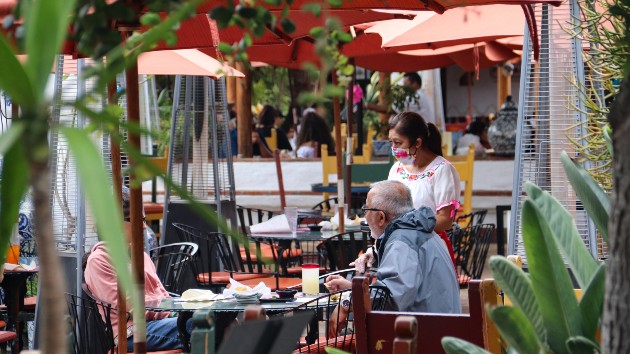
RoamingPanda/iStockBy KAITLYN FOLMER, KAYLEE HARTUNG and KELLY MCCARTHY, ABC News
(NEW YORK) — With limited indoor dining capacity and colder weather fast approaching in many parts of the country, restaurants have worked quickly to create comfortable outdoor dining solutions such as plexiglass pods and handcrafted wooden platforms with mini-greenhouses.
But the once seemingly temporary tents and structures have increasingly become permanent fixtures along sidewalks, streets and parking lots, prompting concerns from public health experts that the benefits of eating outdoors — ventilation, access to outside air, increased airflow — are becoming diminished.
“Outdoors means no walls, no ceiling,” Anne Rimoin, an epidemiologist and professor at University of California, Los Angeles’ Fielding School of Public Health, told ABC News. “When I see these tents consists of walls, [they] don’t have the ventilation the way an indoor restaurant would.”
When a person breathes or talks, they release microscopic droplets from their mouth and nose that can travel with the airflow, which is why proper ventilation is key.
According to experts, outdoor air dilutes any potential virus that may be floating in the air.
“Imagine that somebody is infected and sitting at a table. When they’re breathing and talking, they’re releasing viruses into the air that behave like cigarette smoke,” Linsey Marr, a civil and environmental engineering professor at Virginia Tech, told ABC News. “If there’s poor ventilation, that smoke or those viruses can build up in the air, leaving other people breathing them, too.”
A tented structure with no walls still allows for air to easily flow in any direction through and under the tent, according to Marr.
“Once you start adding walls, you potentially block that wind. Once you add four walls, you’re getting close to being indoors and you lose that benefit of being outdoors,” she said.
The dining igloos and domes have some benefit, said Marr, because they isolate you from other diners.
But if someone in your own dining party is infected, there is high potential to contract the virus because there’s very little airflow by design in these structures.
“I feel it’s only prudent to [be in an igloo] with people in your own household,” Marr said.
She also advised there should be sufficient time between seatings — at least 20 minutes — so the igloo can air out.
The “best case scenario,” according to Marr, is “sitting outside under the great blue sky, no tent, no roof.”
“If someone happens to be infected and is releasing viruses into the air, there’s more of an opportunity for the wind to carry it away,” she said. “What happens is the virus becomes so dilute that the chances of any one person breathing in enough of those to get sick is very, very low.”
Marr explained that even outdoor diners should still behave as though they’re indoors. That includes keeping tables socially distanced, wearing a mask when not eating and minimizing contact with those outside your own party, such as the server.
“There’s no zero-risk scenario,” Rimoin said, “because there’s no control who you’re seated next to and not wearing a mask.”
But she agreed with Marr that an open-sky scenario is the best option because “the more air circulating, the better it is.”
Experts also advise that restaurants reduce the level of background music and noise so that diners can speak more quietly.
According to Marr, a person releases particles just by breathing and talking, so the louder a person talks, the more particles — or aerosols — they release.
“If someone’s infected, they’re going to release viruses in aerosols as they talk. And so if we can, we should try and keep our voices down,” Marr said.
And while heat lamps may make for a more comfortable evening outdoors, they have little effect on increasing air movement and won’t dilute the virus in the air, she added.
Copyright © 2020, ABC Audio. All rights reserved.
